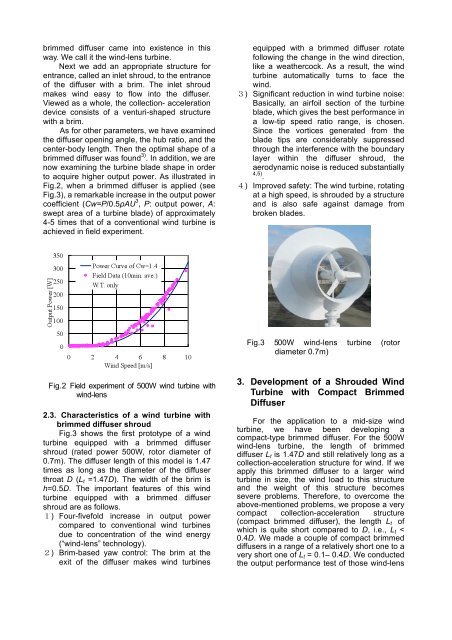A SHROUDED WIND TURBINE GENERATING HIGH OUTPUT ...
A SHROUDED WIND TURBINE GENERATING HIGH OUTPUT ...
A SHROUDED WIND TURBINE GENERATING HIGH OUTPUT ...
You also want an ePaper? Increase the reach of your titles
YUMPU automatically turns print PDFs into web optimized ePapers that Google loves.
immed diffuser came into existence in this<br />
way. We call it the wind-lens turbine.<br />
Next we add an appropriate structure for<br />
entrance, called an inlet shroud, to the entrance<br />
of the diffuser with a brim. The inlet shroud<br />
makes wind easy to flow into the diffuser.<br />
Viewed as a whole, the collection- acceleration<br />
device consists of a venturi-shaped structure<br />
with a brim.<br />
As for other parameters, we have examined<br />
the diffuser opening angle, the hub ratio, and the<br />
center-body length. Then the optimal shape of a<br />
brimmed diffuser was found 3) . In addition, we are<br />
now examining the turbine blade shape in order<br />
to acquire higher output power. As illustrated in<br />
Fig.2, when a brimmed diffuser is applied (see<br />
Fig.3), a remarkable increase in the output power<br />
coefficient (Cw=P/0.5ρAU 3 , P: output power, A:<br />
swept area of a turbine blade) of approximately<br />
4-5 times that of a conventional wind turbine is<br />
achieved in field experiment.<br />
equipped with a brimmed diffuser rotate<br />
following the change in the wind direction,<br />
like a weathercock. As a result, the wind<br />
turbine automatically turns to face the<br />
wind.<br />
) Significant reduction in wind turbine noise:<br />
Basically, an airfoil section of the turbine<br />
blade, which gives the best performance in<br />
a low-tip speed ratio range, is chosen.<br />
Since the vortices generated from the<br />
blade tips are considerably suppressed<br />
through the interference with the boundary<br />
layer within the diffuser shroud, the<br />
aerodynamic noise is reduced substantially<br />
4,5) .<br />
) Improved safety: The wind turbine, rotating<br />
at a high speed, is shrouded by a structure<br />
and is also safe against damage from<br />
broken blades.<br />
Fig.3 500W wind-lens turbine (rotor<br />
diameter 0.7m)<br />
Fig.2 Field experiment of 500W wind turbine with<br />
wind-lens<br />
2.3. Characteristics of a wind turbine with<br />
brimmed diffuser shroud<br />
Fig.3 shows the first prototype of a wind<br />
turbine equipped with a brimmed diffuser<br />
shroud (rated power 500W, rotor diameter of<br />
0.7m). The diffuser length of this model is 1.47<br />
times as long as the diameter of the diffuser<br />
throat D (L t =1.47D). The width of the brim is<br />
h=0.5D. The important features of this wind<br />
turbine equipped with a brimmed diffuser<br />
shroud are as follows.<br />
) Four-fivefold increase in output power<br />
compared to conventional wind turbines<br />
due to concentration of the wind energy<br />
(“wind-lens” technology).<br />
) Brim-based yaw control: The brim at the<br />
exit of the diffuser makes wind turbines<br />
3. Development of a Shrouded Wind<br />
Turbine with Compact Brimmed<br />
Diffuser<br />
For the application to a mid-size wind<br />
turbine, we have been developing a<br />
compact-type brimmed diffuser. For the 500W<br />
wind-lens turbine, the length of brimmed<br />
diffuser L t is 1.47D and still relatively long as a<br />
collection-acceleration structure for wind. If we<br />
apply this brimmed diffuser to a larger wind<br />
turbine in size, the wind load to this structure<br />
and the weight of this structure becomes<br />
severe problems. Therefore, to overcome the<br />
above-mentioned problems, we propose a very<br />
compact collection-acceleration structure<br />
(compact brimmed diffuser), the length L t of<br />
which is quite short compared to D, i.e., L t <<br />
0.4D. We made a couple of compact brimmed<br />
diffusers in a range of a relatively short one to a<br />
very short one of L t = 0.1– 0.4D. We conducted<br />
the output performance test of those wind-lens
















